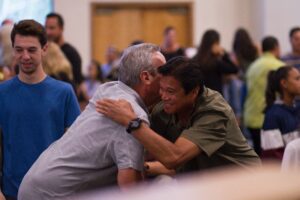
As litigation becomes ever more expensive, time consuming and inaccessible to Canadians, interest in alternatives has been steadily rising. Mediation, peace circles, restorative justice, and conflict coaching are just a few of the alternatives people turn to for help in resolving their conflicts. Though elements of these practices have been around for millennia, a wide variety of ideas, philosophies and methods are associated with each.
This article focuses on describing a model of Community Mediation (CM) that is common throughout North America, the UK and New Zealand. The modern versions of these programs can be traced to humble beginnings that emerged in parallel with the 1960s civil rights movements in the United States. The premise underlying these efforts was that people are inherently capable of resolving their own conflicts. The resulting CM programs were established to create opportunities for this to occur, with a little help from a skilled and impartial third-party.
“Not only could mediation afford participants a sense of power and control over their lives, the open process could also allow participants the opportunity to listen, be heard and create sustainable responses. This approach allowed community mediation participants to humanize each other and look beyond their own assumptions to see each other as real people with real concerns and needs, even in the midst of disagreement.” – https://www.aboutrsi.org/special-topics/community-mediation-basics
The success of these efforts led to an explosion of other initiatives that include over 600 established CM programs today.*
Before delving further into the community aspect however, it may be helpful to review some of the defining features of mediation more generally. Though mediation can take many forms, its five most common characteristics are: It is an informal and confidential process that is facilitated by a skilled and impartial third-party. In addition, people participate on a voluntary basis and the participants are alone responsible for determining the outcome.
Applying this conflict resolution model to the community context works well for several reasons. The first is that the process itself is designed to be empowering. By defining both participation in the process and its outcome as voluntary, participants become masters of their own fate. The logic of this approach is interwoven with the above assumption that everyone has the inherent capacity to resolve their own conflicts.
The second reason is the ongoing nature of the relationships typically involved in community conflicts. A community is defined by the relationships that exist between its members. The more resilient these relationships, the stronger the community. When disputes emerge, these relationships typically persist but their nature and quality is impacted by the way that conflicts are addressed. This in turn, has the potential to impact the community as a whole.
When conflicts are resolved before a court, the focus tends to be on what happened and whether this impinged on various legal rights and responsibilities. When conflicts are resolved through Community Mediation owever, the focus is on why the conflict occurred from each party’s perspective, what harm resulted to the relationship and how to rebuild the trust necessary for this relationship to flourish once more. The confidential nature of Community Mediation in turn helps to establish a safe space in which the parties can speak freely of their experience of the conflict, their hopes for the future, and to create a resolution best suited to their needs, values and resources.
Finally, the lack of a rigid and formal procedure, allows for the process to be adapted to the enormous variety of conflicts, cultures, and concerns that can emerge in a community context. As long as the parties are willing and motivated to work together, the mediator can help to facilitate communication, empower the participants to build empathy and understanding, and support their efforts to emerge from the conflict trap.
The benefits of this approach to resolving community conflicts are clear. Over 50 years of statistics show that the vast majority of Community Mediations result in agreements, that participants then follow through on the agreements that they have designed, and that nearly all participants would trust a Community Mediation program again in the future. In the US and Canada alone, it is estimated that nearly one million conflicts are resolved annually through Community Mediation programs, resulting in approximately $17M of savings in court and associated government expenses.**
If you want to learn more about community mediation or whether it is the right approach for you, contact us today at [email protected].
*M. Grange, Community Mediation, Faculty of Law, University of Wellington, NZ, 2014)
**F. Washington, D.G. Mawn, J. Shedd, State of Community Mediation 2019, https://www.nafcm.org/page/StateofCommunityMediation2019
